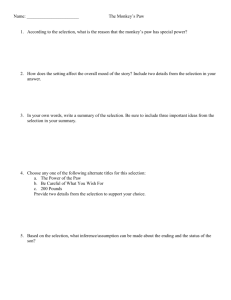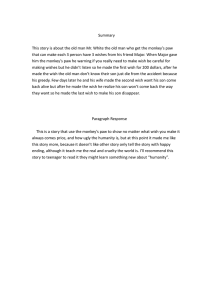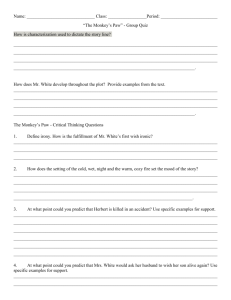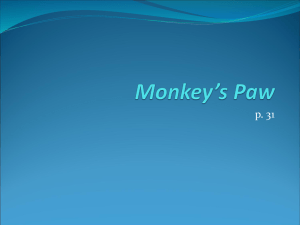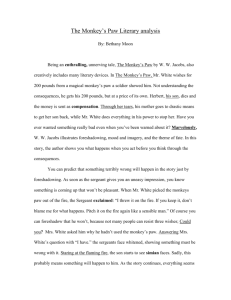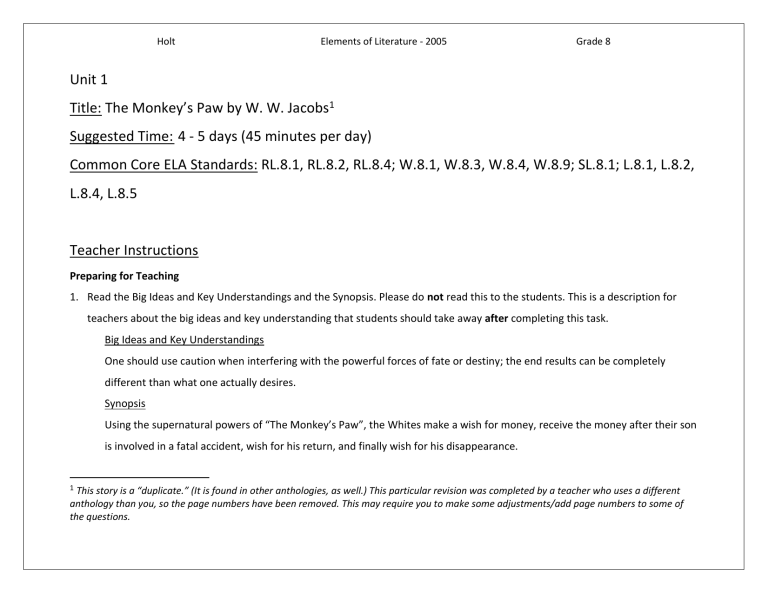
Holt Elements of Literature - 2005 Grade 8 Unit 1 Title: The Monkey’s Paw by W. W. Jacobs1 Suggested Time: 4 - 5 days (45 minutes per day) Common Core ELA Standards: RL.8.1, RL.8.2, RL.8.4; W.8.1, W.8.3, W.8.4, W.8.9; SL.8.1; L.8.1, L.8.2, L.8.4, L.8.5 Teacher Instructions Preparing for Teaching 1. Read the Big Ideas and Key Understandings and the Synopsis. Please do not read this to the students. This is a description for teachers about the big ideas and key understanding that students should take away after completing this task. Big Ideas and Key Understandings One should use caution when interfering with the powerful forces of fate or destiny; the end results can be completely different than what one actually desires. Synopsis Using the supernatural powers of “The Monkey’s Paw”, the Whites make a wish for money, receive the money after their son is involved in a fatal accident, wish for his return, and finally wish for his disappearance. 1 This story is a “duplicate.” (It is found in other anthologies, as well.) This particular revision was completed by a teacher who uses a different anthology than you, so the page numbers have been removed. This may require you to make some adjustments/add page numbers to some of the questions. Holt Elements of Literature - 2005 Grade 8 2. Read the entire selection, keeping in mind the Big Ideas and Key Understandings. 3. Re-read the text while noting the stopping points for the Text Dependent Questions and teaching Tier II/academic vocabulary. During Teaching 1. Students read the entire selection independently. 2. Teacher reads the text aloud while students follow along or students take turns reading aloud to each other. Depending on the text length and student need, the teacher may choose to read the full text or a passage aloud. For a particularly complex text, the teacher may choose to reverse the order of steps 1 and 2. 3. Students and teacher re-read the text while stopping to respond to and discuss the questions, continually returning to the text. A variety of methods can be used to structure the reading and discussion (i.e., whole class discussion, think-pair-share, independent written response, group work, etc.) Text Dependent Questions Text-dependent Questions What does it mean that Mr. White was “amiably desirous of preventing his son from seeing it?” What does Mr. White mean by, “I should hardly think that he’d come tonight”? Explain what the sergeant major means when he states, “it’s Evidence-based Answers Amiable is friendly, pleasing, and sociable. Mr. White was playfully trying to prevent his son from seeing his poor move on the chess board. The Whites are expecting a visitor, but because of their location and the weather, Mr. White believes it is unlikely the visitor will “come tonight.” Mrs. White states, “That’s the worst of living so far out…of all the beastly, slushy, out-of-the way places to live in, this is the worst. Pathway’s a bog, and the road’s a torrent.” “It had a spell put on it by an old fakir”. “He wanted to show Holt Elements of Literature - 2005 Grade 8 just a bit of what you might call magic.” that fate ruled people’s lives….each have three wishes from it”. Why does the sergeant major say, “Better let it burn”? The sergeant-major alludes to his own and others’ bad experiences with the paw. He responded quietly and gravely when asked if he had been granted his wishes. His blotchy face whitened, and he threw the monkey’s paw into the fire. The sergeant-major doesn’t know what the first two wishes of the previous owner were, but the third wish was for death. He doesn’t know whether he would take advantage of three more wishes if that opportunity would arise again. Read the last two paragraphs of Section 1. How does Herbert’s attitude toward the paw shift after his experience with the fire? Cite specific evidence in the text that indicates where the shift occurs. Herbert sarcastically says that he expects that they will find the money in the bed, but should expect something horrible watching them “pocket their ill-gotten gains.” However, after seeing a horrible monkey-like image in the fire, he tries to douse the image with water and actually shivers. His reaction of fear and disgust contrasts with his earlier attitude of disbelief. On page 35, “The first man has three wishes,” was the reply: “I don’t know what the first two were, but the third was for death.” The sergeant-major’s comment indicates that the previous owner’s wishes were so sinister that death was seen as the only possible escape and was actually his final wish. Knowing this, students can foreshadow a sinister fate befalling the Whites should they wish on the paw. Because Mrs. White scurries to the door when she hears the postman’s knock, the reader can conclude that she believes in the supernatural power of the monkey’s paw. She believes the postman is there to deliver the £200. Ironically, the postman is there to deliver a bill. The use of sinister indicates an omen or something evil. By using the word sinister, the author brings up the foreshadowing from previous pages when the White’s learned the fate of the On page ___, identify an example of foreshadowing in the story and explain what this instance foreshadows. Why did Mrs. White go “scurrying to the door at the postman’s knock”? What does the author mean by the “sinister meaning of the assurance” and the “awful confirmation of her fears”? How do the words “sinister” and “awful” contribute to the tone of the Holt Elements of Literature - 2005 text? What is the “horrible fear” that Mr. White experiences on page ___? Why does Mr. White say, “Don’t let it in”? What is Mrs. White’s response? What is Mr. White’s “third and last wish”? Cite evidence from the text to support your response. Grade 8 previous owner of the monkey’s paw. The “awful confirmation” tells the reader that Mrs. White’s worst possible fear has come to fruition. Including these phrases By ordering Mr. White to wish their son alive again, Mrs. White has apparently either not considered or chosen to disregard the possible consequences of seeing her mutilated and decomposing son. This increases the tension between husband and wife because Mr. White is aware of the condition of their son’s body and is astutely aware of the evil which may now accompany Herbert. This is Mr. White’s “horrible fear.” White’s horrible fear is of his son returning in a mutilated state (as evidenced by his use of “it” instead of “him”). Mrs. White cries, “You’re afraid of your own son.” One can infer the final wish was for his son to return to the grave. While the text does not specifically state Mr. White’s final wish, the fact that the moment he found the paw on the floor, he “frantically breathed his third and last wish and the knocking ceased suddenly,” implies that the father’s last wish was for his son to return to where he now belongs. Holt Elements of Literature - 2005 Grade 8 Tier II/Academic Vocabulary Meaning can be learned from context These words require more time to learn (They are abstract, have multiple meanings, are a part of a word family, or are likely to appear again in future texts) Page ___ –surveying, amiably, torrent, intercept, proffered Page ___ – offhandedly, absent-mindedly, fumbling, conscious, regarded, presumptuous Page ___ – enthralled, doggedly, pitch, business, installment, regarded, keenly Page ___ – retire, struck, coloring, marred, wardrobe, gains Page ___ – betokened Page ___ – inaudible Page ___ – wistfully Page ___ – quivering, groped Page ___ – resounded, reverberated Meaning needs to be provided These words require less time to learn (They are concrete or describe an object/event/ process/characteristic that is familiar to students) Page ___ Page ___ Page ___ Page ___ Page ___ Page ___ Page ___ – torrent, intercept – absent-mindedly, presumptuous – talisman – maligned – bibulous – broach – pulsating Page ___ Page ___ Page ___ Page ___ Page ___ Page ___ – installment – prosaic, frivolous, attribute, resolution – courting, wistfully – senseless, resignation – feverishly – suspended, reverberated Page ___ Page ___ Page ___ Page ___ – hospitable, condoling – offhandedly – dubiously, credulity – courting Holt Elements of Literature - 2005 Grade 8 Culminating Writing Task Prompt The fakir “wanted to show that fate ruled people’s lives, and that those who interfered with it did so to their sorrow” (p. 34). Write an essay arguing who is most responsible (Sergeant-Major Morris, Herbert White, Mrs. White, or Mr. White) for the sorrows that resulted from wishing on the monkey’s paw. Support your claims with valid reasoning and relevant and sufficient. Teacher Instructions 1. Students identify their writing task from the prompt provided. 2. Students complete an evidence chart as a pre-writing activity. Teachers should guide students in gathering and using any relevant notes they compiled while reading and answering the text-dependent questions earlier. Some students will need a good deal of help gathering this evidence, especially when this process is new and/or the text is challenging! 3. While the Culminating Writing Task asks students to select one character to write about, this chart includes a sampling of evidence from all four characters. The sample answer will briefly address only one of the characters. Complete the evidence chart for each character. Using the completed chart, decide which one character you will write about. Use evidence from the text in your response, including direct quotes and page numbers. Evidence Quote or paraphrase Sergeant-Major Morris “He took something out of his pocket and proffered it.” “Hold it up in your right hand and wish aloud…” Page number Elaboration / explanation of how this evidence supports ideas or argument Sergeant-Major Morris did not have to take the monkey’s paw from his pocket, nor did he have to teach the Whites how to make a formal wish using the “magical” paw. By doing both, he piqued the curiosity of the superstitious family, thereby Holt Elements of Literature - 2005 He accepted “a trifle” from Mr. White for the paw. Herbert White “Likely,” said Herbert, with pretended horror. “Why we’re going to be rich, and famous and happy. Wish to be an emperor, Father, to begin with; then you can’t be bossed around.” Grade 8 assuming responsibility for the ensuing “sorrows.” His final act of accepting money from Mr. White for the monkey’s paw cements his responsibility for the grief throughout the rest of the story. By making a mockery of the magical powers of the monkey’s paw, Herbert brought grief to his own family. His death and his parents’ reaction to it created shock, grief, and desperation by wishing on the paw. “Well, I don’t see the money….and I bet I never shall.” “I expect you’ll see the cash….ill-gotten gains.” Mrs. White Curiosity – “Monkey’s Paw?” “And what is there special about it?” “And did you really have three wishes granted?” “And has anybody else wished?” “No….we’ll have one more…..wish our boy alive again.” “Wish!” “You’re afraid of your own son…Herbert; I’m coming.” Mr. White “White…stooped down and snatched it off.” “…give it to me.” Mrs. White’s repeated questions illustrate how her curiosity immerses her further and further into the world of the mystique of the paw. She becomes assertive when she orders her husband to make another wish to “wish our boy alive again,” and when she repeatedly orders Mr. White to “wish!” She exhibits the desperation and fierceness of a mother protecting her young when she berates her husband for his fear and calls out to what she believes is her son. Between the curiosity and assertiveness Mrs. White exhibits throughout the story, had she not involved herself in these ways, her greatest sorrow may not have come to pass. Mr. White must accept responsibility for the death of his son for several reasons. He snatched the monkey’s paw from the fire, told Sergeant-Major Holt Elements of Literature - 2005 “I don’t know what to wish for….It seems to me I’ve got all I want.” “I wish for two hundred pounds.” Grade 8 Morris to give him the paw. When he is ready to wish, he realizes there is nothing he needs to wish for, but makes a fatal mistake of wishing for £200. 4. Once students have completed the evidence chart, they should look back at the writing prompt in order to remind themselves what kind of response they are writing (i.e. expository, analytical, argumentative) and think about the evidence they found. (Depending on the grade level, teachers may want to review students’ evidence charts in some way to ensure accuracy.) From here, students should develop a specific thesis statement. This could be done independently, with a partner, small group, or the entire class. Consider directing students to the following sites to learn more about thesis statements: http://owl.english.purdue.edu/owl/resource/545/01/ OR http://www.indiana.edu/~wts/pamphlets/ thesis_statement.shtml. 5. Students compose a rough draft. With regard to grade level and student ability, teachers should decide how much scaffolding they will provide during this process (i.e. modeling, showing example pieces, sharing work as students go). 6. Students complete final draft. Sample Answer: While Mrs. White does not initially appear to be an assertive character in W.W. Jacob’s short story, “The Monkey’s Paw,” her actions throughout the narrative prove that she did indeed interfere with fate and was definitely responsible for the sorrows that befell her family. Her curiosity led to the family being even more curious. Had she brushed the mystic of the paw off as insignificant, perhaps her husband would not have pursued the mystery. Mrs. White peppers Sergeant-Major Morris with questions such as “Monkey’s Paw?,” “what is there special about it?,” “did you really have three wishes granted?,” “and has anybody else wished?” Her insatiable curiosity probably influences her husband to actually wish upon the paw. With every curious question Mr. White also became more curious. As a result Herbert Holt Elements of Literature - 2005 Grade 8 reacted with off-handed remarks which almost seemed to be a challenge to prove the paw had no mysterious value. Had Mrs. White not been so curious perhaps Herbert would have ignored the paw completely and just enjoyed the stories. Once the Whites receive the news of their son’s tragic death, and the company’s ironic compensation of £200, Mrs. White becomes overwhelmed with grief and shrieks. After a week of sleepless nights, Mrs. White realizes that there are two remaining wishes on the paw. Her insistence, on page ___, for her husband to “Wish!” for their son to return from the dead is evidence that she has taken the role of interfering with fate at any cost. Had she been more practical and accepted her son’s death as a coincidence she would never have acted on her thought to wish him back to life. She blatantly berates her husband, which she had not previously done, when she shouts, “You’re afraid of your own son!.” Mrs. White is responsible for the sorrows that befall her family in this story. Mrs. White instigated the continued curiosity with her questions. She then showed she believed in the power of the paw when she allowed the man from Herbert’s company in to the house, assuming he was someone who was going to provide them with the £200 for which they had wished. Finally, her most selfish and damning act was in wishing her dead son alive. Had she not interfered with fate to begin with, and had she not wished her son alive in the end, the horrors of that final night would have never happened. Additional Tasks “The Monkey’s Paw” illustrates that no good can come from testing fate. The conclusion of this story is open to individual interpretation. Students will continue the story from the point of the door opening. The continuation will serve as a new conclusion to the story and should be written in the same tone of “The Monkey’s Paw”. Answer: Students will determine what the third wish is and write a new conclusion to the story. Students should use descriptive language in the new conclusion. Holt Elements of Literature - 2005 Grade 8 Note to Teacher While asking students to make predictions is not a focus of the text-dependent questions, teachers may encourage and guide students to make predictions throughout the first reading of “The Monkey’s Paw”. Holt Elements of Literature - 2005 Name ________________________________________________ Grade 8 Date ___________ “The Monkey’s Paw” 1. What does it mean that Mr. White was “amiably desirous of preventing his son from seeing it?” 2. What does Mr. White mean by, “I should hardly think that he’d come tonight”? 3. Explain what the sergeant major means when he states, “it’s just a bit of what you might call magic.” 4. Why does the sergeant major say, “Better let it burn”? Holt Elements of Literature - 2005 Grade 8 5. Read the last two paragraphs of Section 1. How does Herbert’s attitude toward the paw shift after his experience with the fire? Cite specific evidence in the text that indicates where the shift occurs. 6. On page ___, identify an example of foreshadowing in the story and explain what this instance foreshadows. 7. Why did Mrs. White go “scurrying to the door at the postman’s knock”? 8. What does the author mean by the “sinister meaning of the assurance” and the “awful confirmation of her fears”? How do the words “sinister” and “awful” contribute to the tone of the text? Holt Elements of Literature - 2005 Grade 8 9. What is the “horrible fear” that Mr. White experiences on page ___? 10. Why does Mr. White say, “Don’t let it in”? What is Mrs. White’s response? 11. What is Mr. White’s “third and last wish”? Cite evidence from the text to support your response. Holt Elements of Literature - 2005 Grade 8 Supports for English Language Learners (ELLs) to use with Anthology Alignment Lessons When teaching any lesson, it is important to make sure you are including supports to help all students. We have prepared some examples of different types of supports that you can use in conjunction with our Anthology Alignment Lessons to ensure ELLs can engage fully with the lesson. While these supports reflect research in how to support ELLs, these activities can help ALL students engage more deeply with these lessons. Note that some strategies should be used at multiple points within a lesson; we’ll point these out. It is also important to understand that these scaffolds represent options for teachers to select based on students’ needs; it is not the intention that teachers should do all of these things at every lesson. Before reading: Read passages, watch videos, view photographs, discuss topics (e.g., using the four corners strategy), or research topics that help provide context for what your students will be reading. This is especially true if the setting (e.g., 18th Century England) or topic (e.g., boats) is one that is unfamiliar to the students. Provide explicit instruction, using multiple modalities, on selected vocabulary words that are central to understanding the text. When looking at the lesson plan, you should note the Tier 2 words, particularly those words with high conceptual complexity (i.e., they are difficult to visualize, learn from context clues, and are abstract), and consider introducing them ahead of reading. For more information on selecting such words, go here. You should plan to continue to reinforce these words, and additional vocabulary, in the context of reading and working with the text. (See additional activities in the During Reading and After Reading sections.) Examples of Activities: o Provide students with the definition of the words and then have students work together to create Frayer models or other kinds of word maps for the words. o When a word contains a prefix or suffix that has been introduced before, highlight how the word part can be used to help determine word meaning. o Keep a word wall or word bank where these new words can be added and that students can access later. o Have students create visual glossaries for whenever they encounter new words. Then have your students add these words to their visual glossaries. o Create pictures using the word. These can even be added to your word wall! o Create lists of synonyms and antonyms for the word. o Have students practice using the words in conversation. For newcomers, consider providing them with sentence frames to ensure they can participate in the conversation. Use graphic organizers to help introduce content. Holt Elements of Literature - 2005 Grade 8 Examples of Activities: o Complete a Know, Want to Learn, Learned (KWL) graphic organizer about the text. o Have students research the setting or topic and fill in a chart about it. You could even have students work in groups where each group is assigned part of the topic. o Fill in a bubble map where they write down anything that they find interesting about the topic while watching a video or reading a passage about the topic. Then students can discuss why they picked the information. During reading: Allow ELLs to collaborate in their home languages to process content before participating in whole class discussions in English. Consider giving them the discussion questions to look over in advance (perhaps during the first read) and having them work with a partner to prepare. Allow ELLs to use English language that is still under development. Students should not be scored lower because of incorrect spelling or grammar (unless the goal of the assignment is to assess spelling or grammar skills specifically). When grading, be sure to focus on scoring your students only for that objective. Scaffold questions for discussions so that questioning sequences include a mix of factual and inferential questions and a mix of shorter and more extended responses. Questions should build on each other and toward inferential and higher order thinking questions. There are not many factual questions already listed in the lesson instructions, so you will need to build some in as you see fit. More information on this strategy can be found here. Provide explicit instruction, using multiple modalities, on selected vocabulary words (e.g., 5–8 for a given text) that are central to understanding the text. During reading, you should continue to draw attention to and discuss the words that you taught before the reading. Examples of Activities: o Have students include the example from the text in a student-created glossary. o Create pictures that represent how the word was used in the passage. o Create sentences using the word in the way it was used in the passage. o Have students discuss the author’s word choice. o Examine important sentences in the text that contribute to the overall meaning of the text. Examine sentence structure of a particular sentence. Break down the sentence to determine its meaning. Then determine how this sentence contributes to the overall meaning of the passage. Determine if there is any figurative language in the sentence and have students use context clues to determine the meaning of the figurative language. Holt Elements of Literature - 2005 Grade 8 Use graphic organizers to help organize content and thinking. Examples of Activities: o While reading the text, have students fill in a story map to help summarize what has happened. o Have students fill in an evidence chart while they read to use with the culminating writing activity. Make sure to model with the students how to fill in the evidence chart by filling in the first couple of rows together as a class. Go over the prompt that the evidence should support, making sure to break down what the prompt means before having the students get to work. If some of your students frequently struggle to understand directions, have the students explain the directions back to you. o Provide somewhere for students to store new words that they encounter. Students could use a chart to keep track of these new words and their meanings as they read. o If you had students start a KWL before reading, have them fill in the “L” section as they read the passage. After reading: Reinforce new vocabulary using multiple modalities. Examples of activities: o Using the words that you had students work with before the reading, require students to include the words in the culminating writing task. o Create Frayer models with the words. Then cut up the Frayer models and have the students put the Frayer models back together by matching the pieces for each word. After reading the passage, continue to examine important sentences (1–2) in the text that contribute to the overall meaning of the text. Guide students to break apart these sentences, analyze different elements, and determine meaning. More information on how to do this, including models of sentence deconstruction, can be found here. When completing the writing assignments after reading, consider using these scaffolds to support students depending on their English proficiency. Examples of Activities: o For all students, go over the prompt in detail making sure to break down what the prompt means before having the students get to work. Then have the students explain the directions back to you. o Have students create an evidence tracking chart during reading, then direct them to look back over their evidence chart and work with a group to see if their evidence matches what the rest of the class wrote down. If some of the chart does not match, students should have a discussion about why. o For students who need more support, model the proper writing format for your students and provide them with a properly formatted example for reference. o For newcomers, you may consider creating sentence or paragraph frames to help them to write out their ideas.
